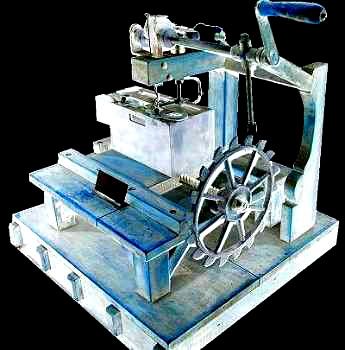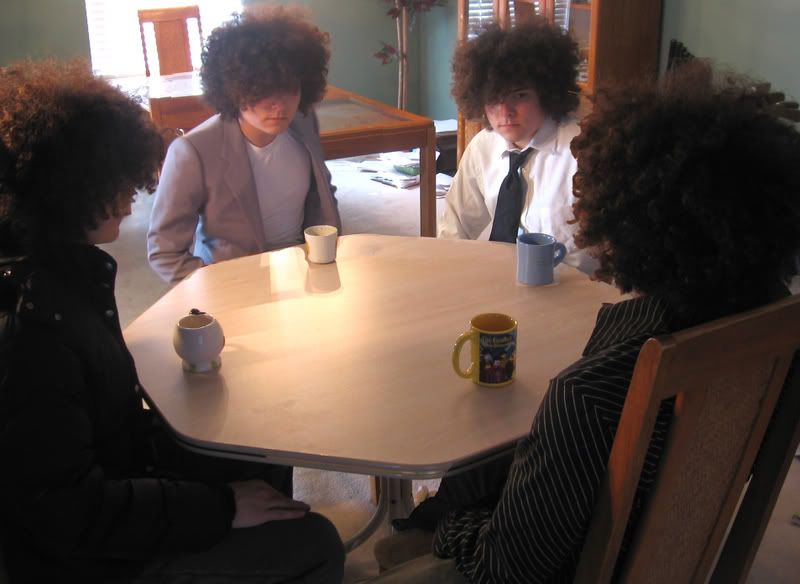My section of the sewing machine's history dates from 1789 to 1821, a period of time that never saw a definitive sewing machine, but many variations and attempts.
 Thomas Saint, an English cabinet maker, made the first semi-funtional sewing machine design. It wasn't used for clothes particularly, but for boots and had the ability to sew leather to canvas in a chain stitch. What made the machine different from previous attempts was the design and function of the machine. With an awl, the leather was punctured and the thread was pulled through by a small needle-like hook. He ignored the sewing machine needle that had already been invented some year earlier by a German by the name of Charles Weisenthal though. Saint achieved this in 1790, and was a great advance in the design of the machine. It's speculated that he himself never made any machines. But there have been attempts at recreating the design, and it never worked quite properly. (picture: replica of Saint's design)
Thomas Saint, an English cabinet maker, made the first semi-funtional sewing machine design. It wasn't used for clothes particularly, but for boots and had the ability to sew leather to canvas in a chain stitch. What made the machine different from previous attempts was the design and function of the machine. With an awl, the leather was punctured and the thread was pulled through by a small needle-like hook. He ignored the sewing machine needle that had already been invented some year earlier by a German by the name of Charles Weisenthal though. Saint achieved this in 1790, and was a great advance in the design of the machine. It's speculated that he himself never made any machines. But there have been attempts at recreating the design, and it never worked quite properly. (picture: replica of Saint's design)In 1804, Thomas Stone and James Henderson worked together to create a machine that attempted to emulate hand stitching. They received a French patent, but the design of it ultimately failed. Still, one step closer to a finalized design. Also in 1804, a Scottish man named John Duncan created a machine that embroidered with multiple needles. The design itself however was unreliable and was a bust. For a few years after this, no real significant advances were made in the field of sewing machines.

The next step in the design process was from a German by the name of Balthasar Krems. In 1810, he invented a machine that could sew together pieces of nightcaps his company made. It actually worked more like a knitting machine, but still considered to be an important piece of the history of the sewing machine. Krems never had this machine patented, so the exact date of it's creation is all speculation. (picture: Krem's machine)
 Josef Madersperger, an Austrian inventor and tailor, became obsessed with creating a machine that would exactly mimic the hand movements of sewing. After numerous attempts and multiple machines, he finally ran out of money later down the road in his life. But the real success of his machine was in the needle. The eye of the needle was close to the tip, an idea that had not been used until he designed it. This was key because this allowed him to use an endless thread, something seen in sewing machines today. But that wasn't enough. Some German's credit him as the inventor of the sewing machine, but that's debatable. In 1815, he patented his machine, but could not perfect it. He later donated it to a museum and was awarded a bronze medal for his ingenuity. He died broke and sick.
Josef Madersperger, an Austrian inventor and tailor, became obsessed with creating a machine that would exactly mimic the hand movements of sewing. After numerous attempts and multiple machines, he finally ran out of money later down the road in his life. But the real success of his machine was in the needle. The eye of the needle was close to the tip, an idea that had not been used until he designed it. This was key because this allowed him to use an endless thread, something seen in sewing machines today. But that wasn't enough. Some German's credit him as the inventor of the sewing machine, but that's debatable. In 1815, he patented his machine, but could not perfect it. He later donated it to a museum and was awarded a bronze medal for his ingenuity. He died broke and sick.The first Americans thrown into the sewing machine wars were John Doge and John Knowles. In 1818, they invented their own version of the "first" sewing machine. It worked, however it could only sew a few inches of fabric before it had to be reset, a process that took a long time. It also malfunctioned frequently, which would later lead to more time in the fixing process. The time it took to operate and fix the machine was more time consuming than hand sewing. So in the end, they couldn't perfect the design either.
The repercussions of the sewing machine were both good and bad. The industrial revolution put many people in terrible working conditions, and with these new sewing machines, work could be done for hours on end with no breaks. But, with sewing machines now inside the home, the common wife could make clothes in a faster fashion. This led to many seamstresses losing their jobs though. In the end, it all evened out and the sewing machine is now a common household product.
It seems as if the evolution of the sewing machine has slowed in the past few years. With the design of it nearly perfected, not many changes need to happen. But if I were to change something about it, I would replace the heavier metals inside to lighter metals. Current sewing machines are very heavy and cumbersome, so I would reduce the size and make it lighter.
Works Cited
Askaroff, Alex. "A Brief History of the Sewing Machine." Sewalot. 2008.
Dickens, Geof. "Origins of The Sewing Machine." Sewing Machine Collector. Mar. 2002.
Forsdyke, Graham. "A Brief History of the Sewing Machine." International Sewing Machine Collectors' Society. ISMACS International.
Forsdyke, Graham. "To the Victor, the Spoils." International Sewing Machine Collectors' Society. ISMACS International.
Holmes, Chuck. "History of the Sewing Machine." Moah. 02 Mar. 2001.
"The origins of the Sewing Machine - a Time Line." Garmento.
